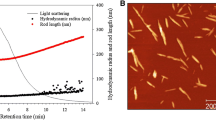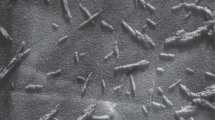In this work dispersions of nanodimensional particles of cellulose were obtained, and their zeta potential at pH values from 1 to 14 was determined. It was established that cellulose nanofibrils (CNF) retains its sedimentation stability at pH values from 3 to 11. Here CNF obtained by acid treatment with homogenization has a maximum zeta potential of about – 62 mV at pH = 6. CNF obtained by oxidative treatment with homogenization has maximum zeta potential of about –46 mV at pH = 7. Cellulose nanocrystals obtained by oxidative treatment with homogenization retains its sedimentation stability at pH values from 4 to 11 and has a maximum zeta potential of about –73 mV at pH = 4.


Similar content being viewed by others
References
T. Li et al., Nature, 590, 47-56 (2021).
Ya. A. Masyutin et al., Chemistry and Technology of Fuels and Oils, 53, No. 5, 633-637 (2017).
M. S. Kotelev et al., Chemistry and Technology of Fuels and Oils, 53, No. 5, 722-726 (2017).
E. Yu. Kozhevnikova et al., Chemistry and Technology of Fuels and Oils, 54, No. 1, 733-737 (2017).
R. K. Mishra, A. Sabu, S. K. Tiwari, J. Saudi Chem. Soc., 22, No. 8, 950-970 (2018).
Mattos B. D. et al., Science Advances, 6, No. 19, 7328 (2020).
K. Heise et al., Advanced Materials, 33, No. 3, 2004349 (2021).
J. K. Jackson et al., International Journal of Nanomedicine, 6, 321-330 (2011).
V. A. Vinokurov et al., Polymers, 11, No. 5, 919 (2019).
S. A. Konstantinova et al., Chemistry and Technology of Fuels and Oils, 55, No. 5, 561-567 (2019).
S. Yang et al., Separation and Purification Technology, 119524 (2021).
M. Shimizu et al., Cellulose, 27, 1357-1365 (2020).
J. P. S. Morais, Carbohydrate Polymers, 91, No. 1, 229-235 (2013).
K. Uetani, H. Yano, Langmuir, 28, No. 1, 818-827 (2012).
A. A. Novikov et al., Chemistry and Technology of Fuels and Oils, 54, No. 5, 564-568 (2018).
The work was funded by the Ministry of Education and Science of the Russian Federation within the framework of a state assignment, project 0768-2020-0007. The reported study of B. Anikushin was funded by RFBR, project number 19-38-90292.
Author information
Authors and Affiliations
Corresponding author
Additional information
Translated from Khimiya i Tekhnologiya Topliv i Masel, No. 6, pp. 41–43, November – December, 2021.
Rights and permissions
About this article
Cite this article
Anikushin, B.M., Lagutin, P.G., Kanbetova, A.M. et al. Zeta Potential of Nanosized Particles of Cellulose as a Function of pH. Chem Technol Fuels Oils 57, 913–916 (2022). https://doi.org/10.1007/s10553-022-01328-0
Published:
Issue Date:
DOI: https://doi.org/10.1007/s10553-022-01328-0




